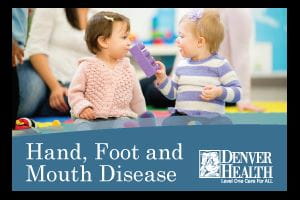 What is hand, foot and mouth disease?
What is hand, foot and mouth disease?
Hand, foot and mouth disease is a contagious, viral infection that causes sores in the mouth and a rash on the hands and feet. It is most common in young children. Download a hand, foot, and mouth disease fact sheet.
How is hand, foot and mouth disease spread?
Hand, foot and mouth disease can be spread person-to-person through:
- An infected person sneezing, coughing or blowing their nose near another person.
- Close personal contact.
- Contact with objects and surfaces that an infected person has touched, like a toy or doorknob.
- Hand, foot and mouth disease is not transmitted to or from pets or other animals, and is different from hoof and mouth disease.
What are the symptoms of hand, foot and mouth disease?
The most common symptoms include:
- Fever
- Sore throat
- Painful, red blisters on the tongue, gums and inside of cheeks
- A red rash on hands, feet and sometimes buttocks
- Irritability in infants and toddlers
- Loss of appetite
Who is most at risk?
- Children younger than five years old and in close contact with other children, such as in child care centers.
What should I do if I think I have hand, foot and moth disease?
- People who think they may have this disease should contact their health care provider.
- Adults and children with this disease should stay home while they have symptoms.
- In most cases, a person with hand, foot and mouth disease is most contagious during the first week of illness. However, people can be contagious for days or weeks after symptoms go away.
- Some people, especially adults, may not develop symptoms, but can still spread the virus to others.
How is hand, foot and mouth disease treated?
- Over-the-counter medications can relieve pain and fever such as Tylenol® and Children's Tylenol.® (Aspirin should not be given to children.)
- Use mouthwashes o sprays that numb mouth pain.
- Drink plenty of fluids, avoiding juice and soda, as the acid in these beverages can irritate the blisters in the mouth.
How can I prevent hand, foot and mouth disease?
- Wash hands often with soap and water, especially after changing diapers and using the toilet.
- Clean and disinfect frequently touched surfaces and soiled items, including toys.
- Avoid close contact such as kissing, hugging or sharing utensils or cups with people who have the disease.
For more information, call Denver Public Health, 303-602-3614.


